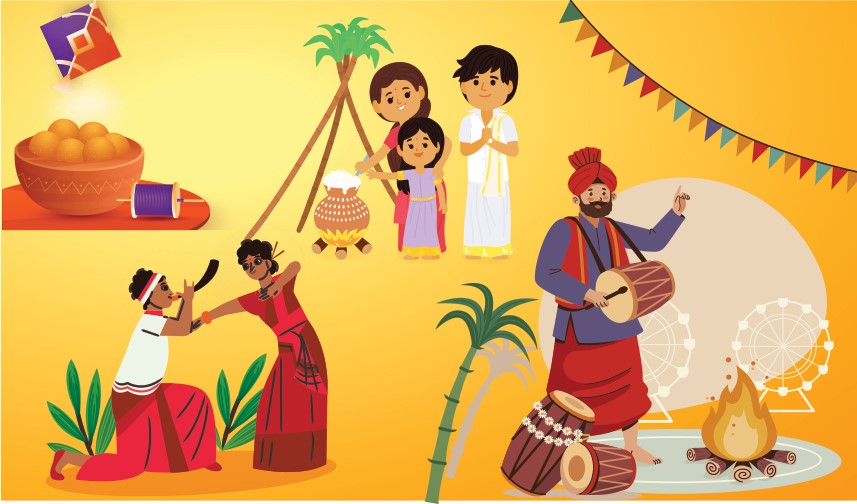Description

Disclaimer: Copyright infringement not intended.
Context
Cultural celebrations are held across many states of India under different names – Makar Sankranti, Pongal, Magh Bihu, etc. on January 14. Unlike many Hindu festivals, the date for these festivals is largely fixed.
Details
Makar Sankranti
- Makar Sankranti, also known as Uttarayana, is a Hindu festival celebrated annually on January 14 (or January 15 in a leap year).
- It signifies the sun's transition into the zodiac sign of Capricorn (Makara), marking the end of the winter solstice and the beginning of longer days.
- Dedicated to the solar deity Surya, Makar Sankranti is a festival of immense cultural, religious, and agricultural significance observed throughout India.
Cultural Diversity:
- Celebrated under various names across India and neighboring countries, including Pongal, Magh Bihu, Uttarayana, and others.
- Each region has its unique customs and rituals associated with the festival.
Rituals:
- Punya Kaal Activities: Activities like bathing, offering Naivedhya to the Sun god, charity, Shraddha rituals, and breaking the fast are performed during Punya Kaal. If Makar Sankranti occurs after sunset, these activities are postponed until the next sunrise.
- Sacred River Bathing: Worshippers often take a dip in sacred rivers such as the Ganga, Yamuna, Godavari, Krishna, and Cauvery to cleanse themselves of sins.

Social Festivities:
- Decorations and Melas:
- Social festivities include colorful decorations, melas (fairs), and dances.
- Rural children go house to house, singing and seeking treats in some regions.
- Kite Flying:
- In Gujarat, the festival is celebrated with kite flying, symbolizing breaking free from the past and reaching new heights.
- Bonfires and Feasts:
- Bonfires are lit, symbolizing the end of winter, especially in regions like Punjab.
- Families come together, celebrate around bonfires, and enjoy feasts.
Historical Context:
- The Hindu epic Mahabharata mentions the Magha Mela associated with Makar Sankranti.
- Every twelve years, Makar Sankranti coincides with Kumbha Mela, one of the world's largest mass pilgrimages, attracting millions of people.
- Sankranti is worshipped as a deity who, according to legends, vanquished the demon Sankarasur.
Lohri
- Lohri is a popular Punjabi festival celebrated primarily by Sikhs and Hindus.
- It marks the end of winter and the arrival of longer days. This festival is especially significant for communities in the Punjab region of India.
- Lohri is celebrated on the 13th of January every year.
- The day holds cultural and traditional significance, as it is associated with the harvest season and the winter solstice.
Celebrations and Customs:
- Bonfire Ritual: The central element of Lohri celebrations is the lighting of bonfires. People gather around the fire, sing traditional songs, and throw offerings like sesame seeds, gur (jaggery), and rewri (sesame sweets) into the flames.
- Dance and Music: People engage in Bhangra and Gidda, traditional Punjabi dance forms, around the bonfire. The lively beats of the dhol (drum) and the tunes of folk songs create a joyous atmosphere.
- Traditional Attire: People dress in vibrant Punjabi attire, with women wearing colorful suits and men donning kurta-pajama or traditional Punjabi clothing.
- Feast: Special Lohri dishes, such as sarson da saag (mustard greens) and makki di roti (cornbread), are prepared. People also exchange sweets and other festive foods.
Bihu
- Bihu is a set of three Assamese festivals—Magh Bihu, Bohag Bihu, and Kati Bihu—celebrated with enthusiasm in the state of Assam, India. Each Bihu marks a different agricultural stage and season.
Dates and Significance:
- Magh Bihu (Bhogali Bihu): Celebrated in January, it marks the end of the harvesting season.
- Bohag Bihu (Rongali Bihu): Celebrated in April, it marks the Assamese New Year and the onset of the Assamese agricultural year.
- Kati Bihu (Kongali Bihu): Celebrated in October, it is associated with the completion of sowing.
Celebrations and Customs:
- Feasting: Magh Bihu involves community feasts where traditional Assamese sweets and dishes are shared.
- Bonfires: Magh Bihu is marked by the lighting of bonfires, and people participate in traditional Assamese games like buffalo fights.
- Cultural Performances: Bihu is incomplete without traditional folk dances and songs performed by both men and women.
- Hut Construction: In Magh Bihu, makeshift huts called "Meji" and "Bhelaghar" are constructed and later burned, symbolizing the end of the harvesting season.
Pongal
- Pongal is a harvest festival predominantly celebrated in the southern Indian state of Tamil Nadu.
- The festival extends for four days and is dedicated to the Sun god.
- Pongal usually takes place from the 13th to the 16th of January, and it coincides with the Tamil month of Thai.
- The term "Pongal" refers both to the festival and the dish prepared during the celebrations.
.jpg)
Celebrations and Customs:
- Bhogi Pongal: The first day involves the disposal of old belongings, and a bonfire is lit to mark the destruction of the old and the beginning of the new.
- Thai Pongal: The main day is dedicated to boiling the newly harvested rice with milk and jaggery, symbolizing abundance and prosperity. The dish is then offered to the Sun god.
- Maattu Pongal: This day is dedicated to cattle, and they are adorned with flowers and worshipped.
- Kaanum Pongal: The final day involves visiting friends and family, and offerings are made to birds.
Summary of the regional variations
- Andhra Pradesh and Telangana:
- Four-day celebration: Bhogi, Sankranti, Kanuma, Mukkanuma.
- Rituals include decorating homes with Muggu (geometric patterns) and offering Ariselu, a traditional sweet dish, to the god Surya.
- Assam:
- Celebrates Magh Bihu, marking the end of the harvesting season.
- Features feasts, bonfires, and traditional Assamese games like tekeli bhonga and buffalo fighting.
- Bihar:
- Known as Sakraat or Khichdi.
- People eat Dahi and Chura (flattened rice) and sweets made of sesame seeds and jaggery.
- Goa:
- Known as Sankrant.
- People distribute sugar-coated till pulses, offer pots filled with newly harvested food grains to the deity.
- Gujarat:
- Celebrates Uttarayana with a major festival lasting two days.
- Kite flying is a significant activity, and special dishes like Undhiyu and chikkis are enjoyed.
- Haryana and Delhi:
- Celebrates "Sakraant" with ritual purification, holy dips, and traditional Hindu rituals.
- Involves preparing special dishes like kheer, churma, and distributing til-gud laddoos.
- Jammu:
- Celebrated as 'Uttrain,' beginning with Lohri.
- Tradition of 'Mansana' involves charity of Khichdi of Maah Dal.
- Holy bath in Devika river and pilgrimages are common.
- Karnataka:
- Celebrates Suggi, a harvest festival.
- Involves the exchange of plates containing sesame seeds, fried groundnuts, coconut, jaggery, and shaped sugar candy molds.
- Rituals include the display of decorated cows and bulls.
- Maharashtra:
- People exchange til-gul (sweetmeats made from sesame seeds and jaggery).
- Traditional dishes like Gulachi poli and tilacha halwa are enjoyed.
- Married women celebrate Haldi-Kunku.
- Odisha:
- Known as Makara Sankranti.
- People prepare makara chaula and perform rituals at the Konark temple.
- Makara Mela is observed in various locations.
- Punjab:
- Celebrates Maghi with a major mela at Sri Muktsar Sahib.
- Ritual bathing in rivers is essential.
- Lighting lamps with sesame oil is believed to bring prosperity.
- Rajasthan and Western Madhya Pradesh:
- Celebrates "Makar Sankrati" or "Sakraat."
- Involves the flying of kites and the exchange of gifts.
- Traditional delicacies and sweets are enjoyed.
- Tamil Nadu and Puducherry:
- Celebrates Pongal, a four-day festival.
- Involves rituals like Bhogi Pandigai, Thai Pongal, Maattu Pongal, and Kaanum Pongal.
- Traditional activities include Jallikattu (bull-taming) and the exchange of sweets.
- Kerala:
- Known as Sankranti or Makara Sankranti.
- Involves the celebration of Makaravilakku in Sabarimala.
- Tripura:
- Celebrates Hangrai with rituals of immersing ancestors' remains in the holy river.
- Uttar Pradesh:
- Known as Kicheri in Purvanchal and Awadh parts.
- Ritual bathing, prayers, and generous gifting are part of the celebration.
- Uttarakhand:
- Celebrated as Uttarayani, Khichri Sangrand, Pusyodia, Ghughutia, etc.
- The Uttarayani mela in Bageshwar involves rituals, bathing, and offerings.
- West Bengal:
- Celebrates Poush Sankranti with Poush Parbon.
- Preparation of traditional Bengali sweets (Pitha) and worship of Goddess Lakshmi.
- Three-day festival with cultural participation.
|
PRACTICE QUESTION
Q. Which saying is associated with the tradition of 'Ellu Birodhu' in Karnataka during Makar Sankranti?
A. "Eat the mixture of sesame seeds and jaggery and speak good words."
B. "Light the lamps and spread joy."
C. "Fasting and prayers bring prosperity."
D. "Dress in bright colors and dance."
Answer: A
|















